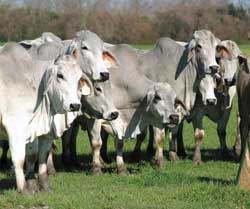|
Brahman Influence Good For Louisiana Cattle Producers
BATON ROUGE, LA.
The traditional stereotype for cattle with high Brahman influence has been that the meat is too tough. But with improved genetics, that seems to be changing.
There is still a problem with tenderness in Brahman, a Bos Indicus or humped-type of cattle that is being addressed and the data is favorable, said LSU AgCenter animal scientist Matt Garcia.
Research that began at the LSU AgCenter to evaluate the Brahman-influenced cattle for tenderness has developed into a program that has become national in scope.
For nearly three decades, beginning in the 1980s, now-retired LSU AgCenter researcher Don Franke conducted crossbreeding research with the Brahman breed.
More recently, Franke studied the meat quality of purebred Brahman steers and found that genetic markers could be used to identify those that will produce acceptable carcasses based on quality grade and tenderness.
AgCenter scientists agree that the industry is more accepting of carcasses with up to one-quarter Brahman breeding. The problem comes when the one-quarter threshold is exceeded.
“We’re part of the American Brahman Breeders Association’s National Carcass Evaluation,” Garcia said. “The carcass scores from Louisiana steers improve every year.”
The carcass reports on purebred Brahman steers sent to the feedlot in 2011 all graded choice, which is one level below prime, Garcia said.
Producers believe Brahman-influenced cattle take a price deduction at the sale barn, said LSU AgCenter economist Ross Pruitt.
“In reality, when those cattle hit the feedlots and they perform, the price for that animal will be passed on down to the person it was bought from,” Pruitt said.
According to the American Brahman Association, the breed is the first beef breed developed in the United States. It is ranked No. 1 in hybrid vigor, heat tolerance and efficiency compared with all other beef breeds.
As with any other animal breed, it has its negatives, including fertility problems, according to Garcia. Most won’t breed until they are 2 years old, which is older than other breeds.
For many years, Louisiana cattle producers have crossbred Brahman cattle with non-humped cattle in order to get heat tolerance, disease resistance and hybrid vigor.

Brahman cattle at the LSU AgCenter Ben Hur
Research Farm in Baton Rouge, Louisiana.
Photo by John Wozniak
“The reason that Brahman crossbreeding started in places like south Texas, Louisiana, Mississippi, Alabama and Florida is because the cattle before had been bred in places like Scotland, England and the Alps of France,” Garcia said. “You take an animal like that and put him in south Louisiana, and it feels like it’s going to die.”
Manuel “Boo” Persica, LSU AgCenter meats lab manager, said every beef animal should not be expected to produce USDA prime beef.
“Not all cattle are destined for Kansas City, where a large number of cattle are fed and raised for high-end meat cuts,” Persica said. “We are accustomed to a certain taste that we get from a high-select through a low to average choice marbling range.”
Meat with more marbling is normally more tender, Persica said. “It’s just easier to chew through fat than to chew through muscle.”
Calving problems come when a Brahman bull is bred to a non-Brahman cow, Garcia said, primarily from high birth weights.
“You have to find a bull by looking through his expected progeny differences for his breeding values,” Garcia said.
“You’re not in the cattle business unless you know what you’re doing,” he said. “Louisiana cattlemen know what they are doing, and that makes it difficult for them to try something new.”
Chris Shivers, executive vice president of the American Brahman Breeders Association in Houston, Texas, said the first humped cattle came into the United States from India in the mid-1800s.
“These cattle came into St. Francisville, Louisiana, to a Mr. Barrow, a sugarcane farmer, who had gone to India to teach them some new practices in farming sugarcane, and they sent these cattle as trade,” Shivers said.
That was the beginning of the combination of four breeds of cattle that became the Brahman breed, Shivers said. ∆
|
|